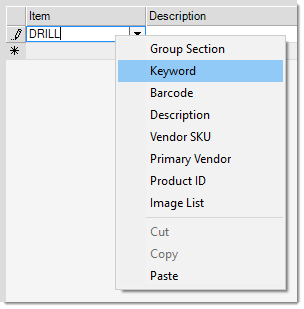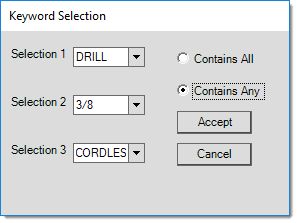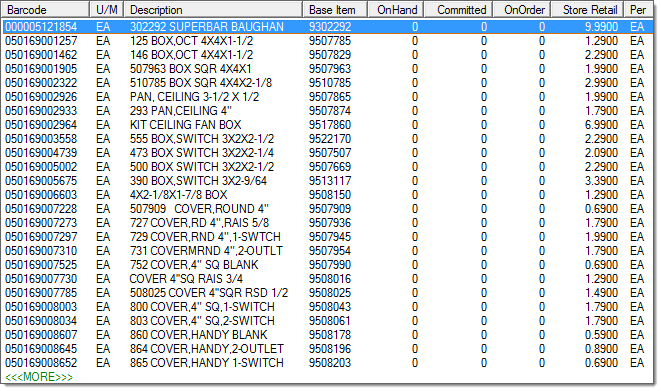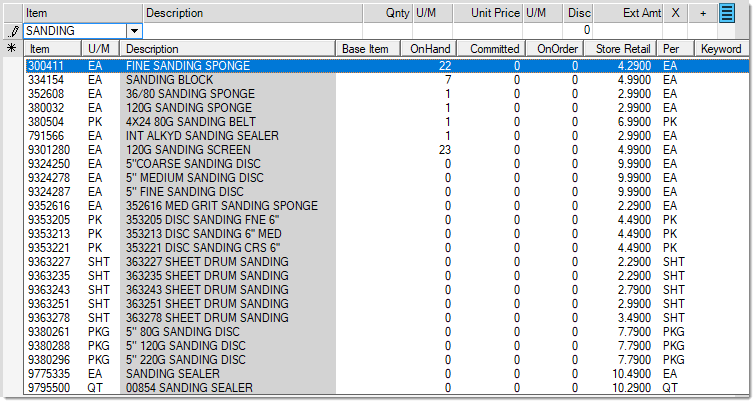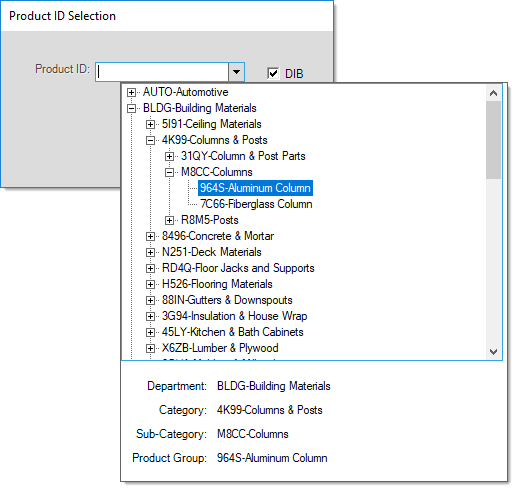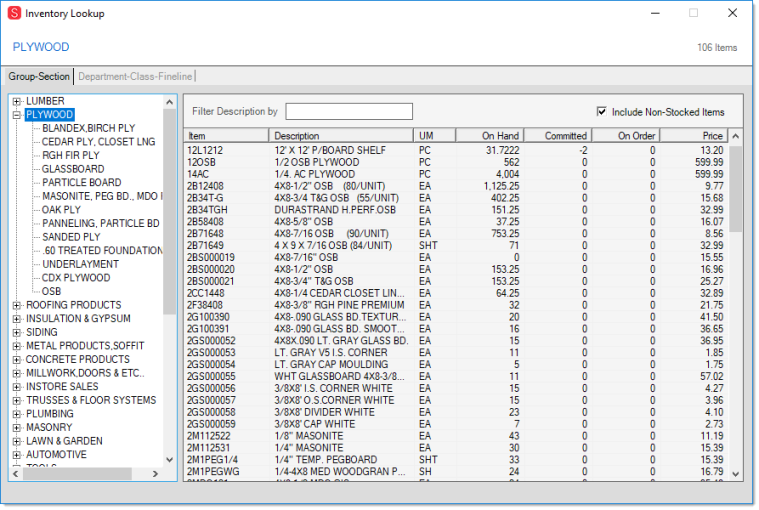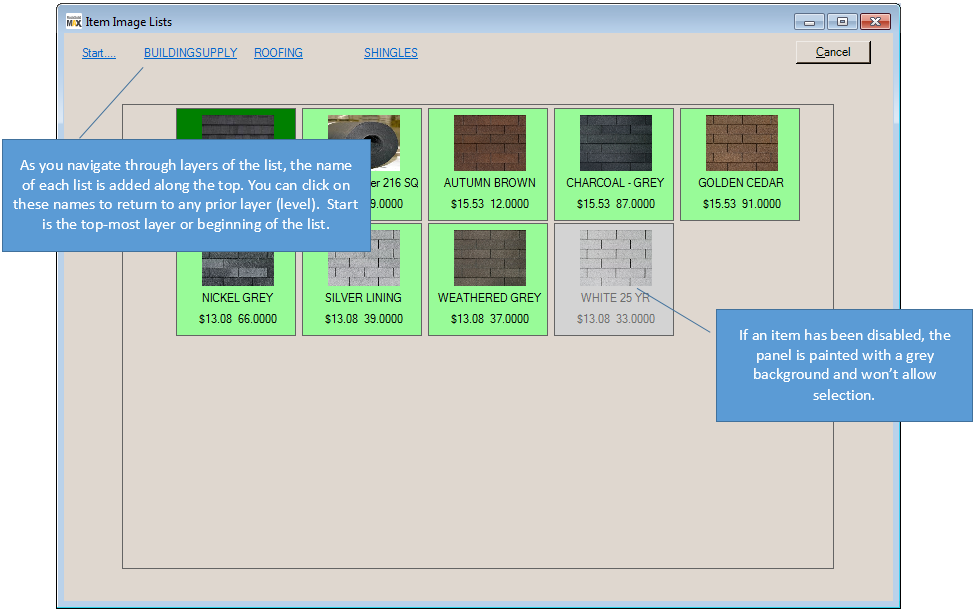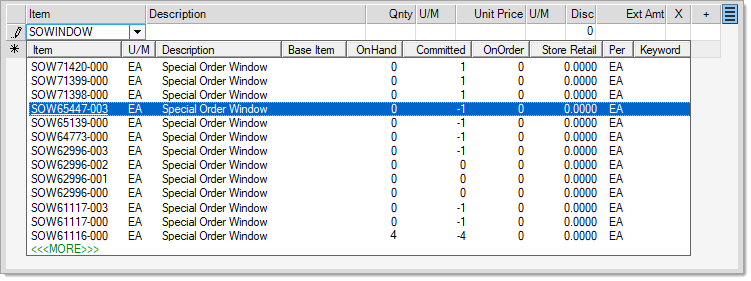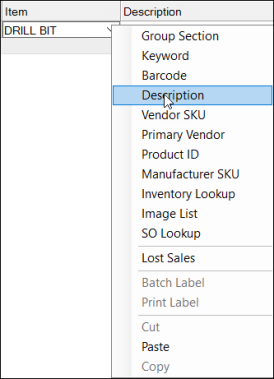Quotes
A "quote" is a list of items that a customer has requested pricing or information regarding, but has not necessarily committed to purchasing. Quotes are available from the Quotes transaction unless purged (voided/deleted). Quotes typically remain available until the close date indicated has past (a daily process marks quote documents as "closed" if they have passed the date). Up to that time, a quote may be resumed (modified) or used to create another transaction type such as a sale or an order. Quote documents are not actually removed even after being closed and may be accessed in other ways. Expiration is considered the end of the period that the quote pricing is promised for. Archived quotes, if data archiving is enabled, would not be available except for inquiry using the Documents form.
As is true with sales or order activities, a quote begins with account (and sometimes job) selection. Next, a quote document ID is generated or entered that is used for identifying the quote in the future.
For information regarding folders in the Point of Sale areas, click here.
Selecting an Account
In the Point of Sale Name list, you can either enter the Sort Name (from the Account Maintenance form) or the account ID. Most Point of Sale transactions involve selecting an account and job (when applicable) first. For Sales, you can scan or enter the items into the data grid first, but for other transaction types (Orders, Quotes, Tickets, etc.), you choose an initial account first. If you know the customer participating in the transaction, there is usually no need to choose an alternate menu, just type either the sort name or the account number/ID.
When a customer has their own charge account, we recommend that you enter their name in the Name list. You can change it to a different account, if needed, before processing.

There are some additional search options you can use, based on other information you know at the time of your search. You can review these option here
Other Search OptionsTo see additional search options, enter the text you know (address, phone number, etc.) in the Name field and right-click the down arrow beside the field to see additional search options.
If you do not enter any text or you enter text that matches more than one account, the application sorts the list by the field (Address, City, etc.) you selected. You can click the column headings to sort the list in a different order. In some cases, only those account's with a value for the selected field(s) will be included. If the Enhanced Look Up option is not enabled, you can also use a "wildcard" (using a % character/symbol) to represent unknown characters to perform a search. A wildcard can represent any character or set of characters before and/or after the text you enter to find records that may match (see the examples below).
You can use wildcards to look for account matches using the alternate menu selections as well. Searching for an Account Using the Customer's Rewards or Loyalty CardIf your company participates with the Do it Best® Loyalty Rewards program, Best Rewards™ or other loyalty rewards programs, you can scan the customer's rewards card ID or enter the customer's card ID in the Name list and choose the UserKey option to perform the search. We should point out that as long as a Loyalty ID is assigned to the customer correctly and the customer's account is used for the transaction, there is no need to scan their card to associate a transaction with the program. All sales transactions will be associated with their rewards ID automatically regardless of whether or not a card was scanned or loyalty ID was used for selection. For ACE Rewards™, choose CTRL-R to scan or enter the customer's rewards ID unless it has been associated with the customer's account. In the latter case, the customer's rewards ID is automatically associated and displayed in a Point of Sale, Sales transaction. Other transactions (Orders, Quotes, etc.) do not support ACE Rewards promotions and these transactions are intentionally not associated with the customer's ACE Rewards ID. Scanning of the customer's ACE Rewards card is not supported except when the ACE Rewards dialog is shown. For more information about using ACE Rewards at Point of Sale, search for the ACE Rewards topic in the Help System. *The customer's rewards ID must be associated with their account in a specific way. Please see the Database > Account documentation for further details. |
When the enhanced look up feature is enabled, you have more selection options, but the account's Sort Name field entry is still the primary match field. The application only shows you account number matches if no sort name matches are found. If matches for both the sort name and account number exist, only the entries with the name display.
Using the Enhanced Account Look Up Feature for Account SearchesWhen enabled, the Enhanced Look Up feature searches using the account number, sort name, address (line 1), and company name automatically. For each row, the cell matching the look up text contains a gray background color. Even when more than one column for the same row (account) has a match, the application only highlights the column with the first look up match. Typically, the more text you enter, the shorter and more useful the list of matching results will be. With enhanced look up, there is a maximum number of matches (up to 70). There is no <<More>> option, which means that if more than 70 matches exist, you may have to either enter additional text to narrow the search or enter new search information instead.
The Enhanced Look Up feature can be enabled by Support upon request. The team sets up parameters and uses a Support Utility to populate tables with the data you have already entered into the application. If you decide you do not want to use this feature after it is enabled, Support needs to reset these tables and the application returns tothe original methods for search. You can request to re-enable this feature in the future if you choose. Key look up data is removed when account or items are modified if you disable the enhanced look-up feature. |
After you select an account from the list, the account type displays beside the list. There are three types of accounts:
-
A Cash account is a customer-specific account that does not allow receivables charges.
-
A Charge account is also a customer-specific account that allow receivables charges to accumulate.
-
A System account is a general-use account that is not customer-specific. A System account does not have a credit limit or allow charges.
All companies must have a system account named CASH. Except in the case of Tickets* (Advice Notes) and Charge Returns, the default account, "CASH," is the default when no specific account is indicated.To select the System account, press TAB . In addition, this type of account requires the entry of a delivery name when used with non-sale type transactions (orders, quotes, etc.). more...
Understanding System Accounts vs. Cash AccountsSystem accounts are used for cash and carry transactions, where the customer doesn't have their own account. Your company can create more than one System account; however, most companies only have one. By contrast, Cash accounts require additional information, such as the customer's name (or other information), for certain payment types and in cases of delivery. When you begin a transaction using a system account, you can create a new "cash-only" account directly using the Delivery tab on the Process form (when applicable). Cash-only and System accounts are not the same. |
Selecting a Job
Accounts may be linked to one or more jobs; every account has at least one job, known as the master job (0). You can add additional jobs to any account to track account activity separately from the account. You are only prompted to select a job if the account has multiple jobs (more than the required job "zero"); otherwise, all activity is assumed to be for the master job. In Point of Sale, disabled and closed jobs are not included in selection list. You may be able to add new jobs during the transaction processing (on the Delivery tab of the Process (F12) form).*

*Your security settings may prevent you from adding jobs during processing.
Quote Selection & Document ID
Like most documents, new quotes may be assigned a sequential number automatically; however, users are able to specify their own ID as well. All document types, including quotes, can be assigned to one of 3 specific numeric ranges. These ranges are used when automatically assigning an ID. When assigning a custom quote ID, the user must do this before any other number/ID is automatically assigned.

The sequence portion of the document identifier can be a maximum number of 6-characters (numbers or letters) in length. When using a custom ID, it's best to use all the characters available (especially if you do document scanning or bar code labels). The standard YYMM date prefix will be added to all quote IDs.

To have the application assign a new quote number instead, press the TAB, Enter (or return) key, or choose "<<<NEW>>>" from the drop down.

This field is also used for selecting an existing quote for modification. If the quote is recent, clicking the drop down lists the most recent quote documents first. If you know the ID, you can type it in. Otherwise, a number of selection options are available from the Quote # drop down's alternate menu (usually a right mouse click).
Delivery Name, Customer PO#, and Delivery Address all seek matches based upon what you have typed in the Quote # field. The "Select" option offers a form with additional Quote selection options (Note: this same form is used with customer orders)...

Removing an Existing Quote
The menu marker ![]() to the right of the quote # field can be used to void an existing quote. "Voided" quotes are removed permanently.
to the right of the quote # field can be used to void an existing quote. "Voided" quotes are removed permanently.
![]()
Quote Locking
If you use quotes as templates for other transactions (via import), there is an option available for "locking" individual quotes. This option will not appear unless it has been enabled by support. This is only done upon request (there is no charge for enabling this option).
When "locking" has been enabled, a "lock quote" option appears on the menu marker after a document ID has been assigned (not before).
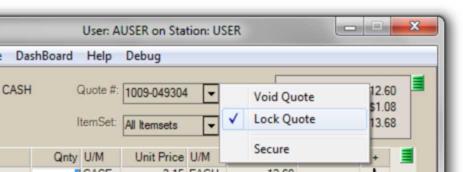
A "check" appears next to the "lock quote" option after locking has been selected.
Locking prevents other users from making any changes to the "locked" quote. The user who locked the quote will be the only one allowed to make changes (including "unlocking" the quote if desired). Once locked, a quote may still be invoiced or ordered by other users. Locking only prevents permanent modifications to the quote by other users. It does not affect whether users change pricing or quantities after the quote is copied into another transaction.
To use a quote repeatedly as a template, the quote should be copied into Sales (Quotes, Orders, etc.) using the Import (F2), Wizard function so that the quote isn't updated as sold, etc.
How this is used may vary based upon whether or not you want the template quote's pricing to change or not. The Import Wizard can be used to select a quote and either keep the original prices or use the customer's current pricing (in this second case, just don't map the price columns). The Import, Document option always reprices the quote to match the selected customer.
ItemSets
An "ItemSet" is a classification tool used for Sales, Orders, and Quotes. This allows the user to assign items to groups, or "sets," which you can may be sort, invoice, or deliver separately. For example, a customer may place a large order, but want specific goods delivered at different times. ItemSets are an excellent way of keeping track of the customer's delivery needs while maintaining a single order at the same time.
Totals Panel
The upper right-hand area of the form includes a display-only panel showing the transaction's current sub-total, sales tax, and total. The tax location and rate (percentage) are displayed to the left of the panel when enough room is available (the tax location and rate can be viewed in the Process (F12) form otherwise). These figures will automatically update as changes are made. Figures also update to reflect any adjustments (adders/discounts, etc.) applied on the Process (F12) form.
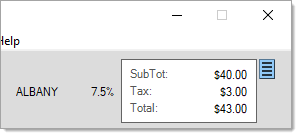
The menu marker (to the right of the totals panel) offers additional options allowing the user to switch to a different transaction type (sale, quote, ticket) or display the current GM% (gross margin percentage) for the entire transaction.
|
|
|
Users in Canada can double click on the tax amount to display the split provincial (PST) and GST tax dollar amounts. For Canadian provinces with both PST and GST taxes, both locations (and rates) are displayed to the left of the totals panel. HST (Harmonized Sales Tax) locations (used for the Maritime provinces) combine the GST and any local amounts together into one tax rate, so no split is provided in those cases. 
Tax Details (Canada Only) |
Grid & Item Entry
The grid is used for item entry. Inventory being sold may be entered or scanned at any time. A "discountable" column (Disc) has been added with release 8.1.0 (January 2013). This can be used to view the discountable status of the item or to specify a line-item discount (if the item is discountable).

Item Entry in Quotes
Primary entry fields include all columns except description, extended amount, and additional information.
![]() For more information about item entry and selection, click here.
For more information about item entry and selection, click here.
Selecting Items using Group Section
Selecting Items using a Keyword
Selecting Items using a Barcode
Selecting the Item using the Description
Selecting Items using a Vendor SKU
Selecting Items using the Primary Vendor
Selecting the Item using the Product ID
Selecting the Item using the Manufacturer SKU
Selecting the Item using Inventory Look up
Inventory Lookup : Group-Section
Inventory Lookup : Department - Class - Fineline
Selecting Items using the Image List Selection
Selecting Items using SO Lookup
Selecting Items using Lost Sales
Unit of Measure Changes
Quantities and pricing reflect the unit of measure displayed. Changing the unit of measure (U/M) to a measure with some other value (other than 1:1) can optionally modify the related quantity or price. If the "convert" box is checked ![]() , the existing quantity or price will be converted to a value equal to the current value (displayed in the drop down). The "convert" option will not change existing extended amounts. If the "convert" option is not checked, the existing quantity or price will not change, and will be used to re-calculate extended amounts.
, the existing quantity or price will be converted to a value equal to the current value (displayed in the drop down). The "convert" option will not change existing extended amounts. If the "convert" option is not checked, the existing quantity or price will not change, and will be used to re-calculate extended amounts.
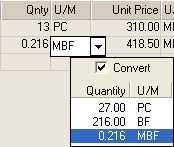
Pricing Changes
There are a number of ways to affect pricing. Users can modify the price by typing another in, select a reprice option (F6), type a discount, or select an alternate price from the input drop-down. Typed keyboard shortcuts are also available. For example, type L2 in the unit price field to use the level 2 price, or D20 to do a 20% discount.
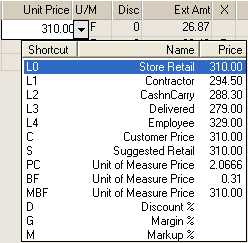
Discount
The "Disc" or "discount" column has two (2) purposes. If an item allows discounts, the column can be used to specify a line item discount by entering a percentage. For items which are not discountable, the column will display the letter "N" (net) and won't allow changes. To mark all items on the transaction as "net," you can use the "Mark as Net" option available from the menu marker ![]() found on the right-hand side of the grid (user security can limit your ability to view or utilize menu marker functions).
found on the right-hand side of the grid (user security can limit your ability to view or utilize menu marker functions).
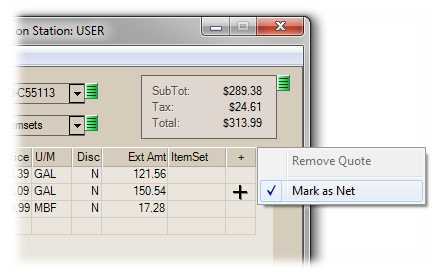
Mark As Net
Using "Switch to" to Change Transactions*
It's possible to begin a Point of Sale transaction as one type and change to another while retaining much of the information from the original. All items (and item comments), pricing, customer-job selection, customer PO#, and
To "switch" transactions, use the menu marker ![]() next to the totals panel in the upper right-hand corner of the application window:
next to the totals panel in the upper right-hand corner of the application window:
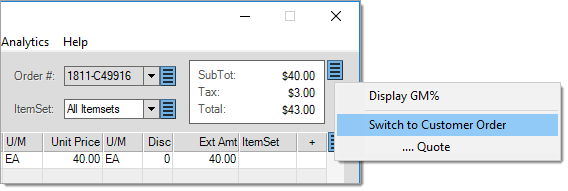
*Security settings can block a user from viewing, and therefore accessing, any menu marker options.
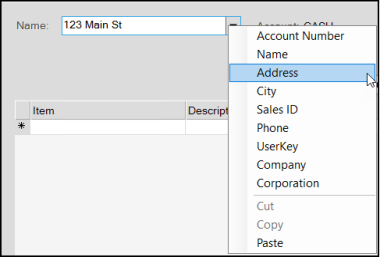


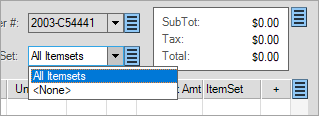


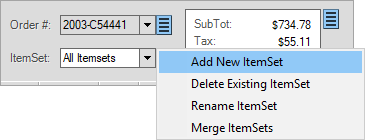
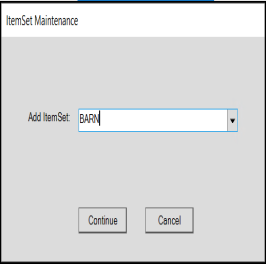
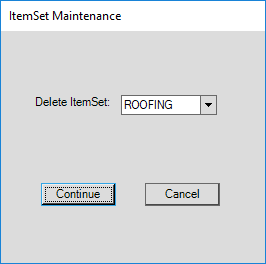
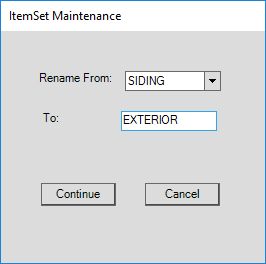
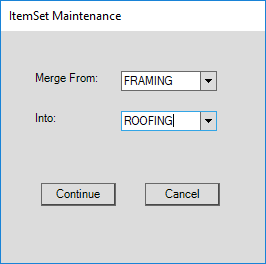

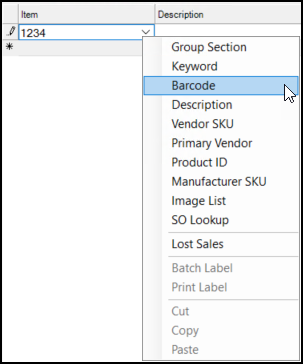
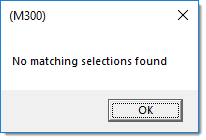


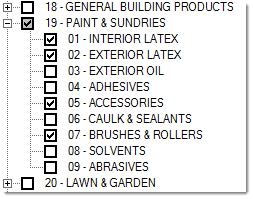
 . If you select some but not all sections within the same group, the group's check box background is changed to gray
. If you select some but not all sections within the same group, the group's check box background is changed to gray  . Use the Select All button to select all groups and sections. Use the Clear All button to clear all check boxes. Choose Accept to build a selection list based upon the groups and/or sections you have chosen (checked). Or, click Cancel to close the window and
. Use the Select All button to select all groups and sections. Use the Clear All button to clear all check boxes. Choose Accept to build a selection list based upon the groups and/or sections you have chosen (checked). Or, click Cancel to close the window and 